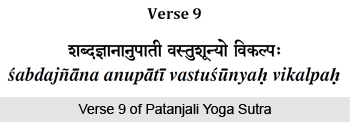The drk darsanasaktyoh ekatmata iva asmita yogic sutra spells out the analyses of egoism, or asmita, as is coined in yogic aspects. By differentiating the various levels of cognition, one can understand the concept of individuality. The exterior egoism takes over a being when he fails to distinguish between the inner and outer self. And if one succeeds in traversing through the two states, and overcomes seeing the outer mind, he is bound to experience reality.
drk power of vision, cause to see, power of consciousness
darsana power of seeing, looking, displaying, inspecting,
perceiving
saktyoh ability, capability, strength, power
ekatmata having the same nature, in the same manner
iva as if, appearance
asmita egoism
 Egoism is the identification of the seer with the instrumental power of seeing.
Egoism is the identification of the seer with the instrumental power of seeing.
Distinguishing the instruments of cognition - the senses of perception, intelligence and ego or the sense of the individual self - with the pure seer is egoism, or the conception of individuality.
Here is an instance of avidya. Iron and coal are two different entities, but when iron is heated, it becomes red hot and looks like live coal. Likewise, though the body and the eternal Self are dissimilar entities, lack of knowledge makes one believe that they are one. Taking pride in the body as the Self is also avidya.
Though there is a dissimilarity between the seer (atma) and the seen, during the act of perceiving the seen (the mind itself) looks as if the pure seer. This appearance of merging or `oneness` is because of asmita.
One must be aware of the difference between the seer (atma) and the instrument that sees (buddhi). If they coalesce and work together, that experience is reality. But if the mind and senses - the seer`s agents, take it upon themselves to identify with the true seer, as though the seer were manifest or apparent, then polarities are created and seer and seen become separated or split. This is asmita.




















